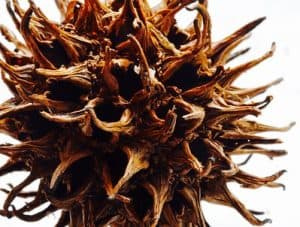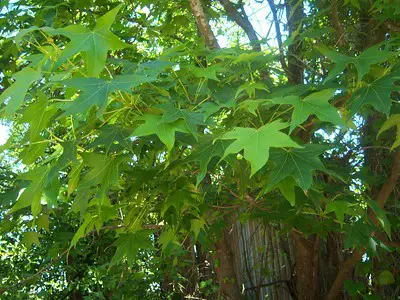So, Can You Burn Sweet Gum Wood In A Wood Stove?
Yes. Burning sweet gum with firewood is not common, but you can do it. In fact, it’s proven that sweet gum can produce up to 20.6 million BTUs per cord when used as a fuel.
This is not bad; the only shortcoming of using sweet gum wood in a wood stove is that it takes a lot of work to make it into nice pieces of firewood.
The sweet gum tree grows in the United States and is highly valued in the lumber industry. Besides, the tree is used in making furniture and ornamental pieces.
These trees are known as liquidambar styraciflua, storax, star-leaved gum, alligator wood or redgum.
The hardwood grows naturally in swampy and moist soils, which are mostly found in lowlands.
What does Sweet Gum Wood look like?
The wood is reddish brown combined with whitish sapwood and beautiful black grain that runs through the wood.
It has unique star-shaped leaves along with spiked fruits and it can grow tall up to 150 feet.
The spiked fruits fall around the area where these trees grow and can cause injuries when walked on.
The tree can live for over 400 years and remains of the most treasured types of tree in the US.
Is Sweet Gum Usable?
Though it’s not a popular choice as firewood, sweet gum trees can be used in a wood stove. This hardwood does not split, twist or shred easily.
To make your work easier, use a hydraulic splitter.
Most people avoid it and have mixed reviews on this wood as firewood. However, despite being so hard to prepare and stack, it is usable in a wood stove.
Most people stay away from it because they find the trouble of cutting into pieces too much. It has the ability to produce large amounts of heat.
Splitting sweetgum wood
Most wood splitting experts will tell you how difficult it is to split the sweet gum wood. It is actually harder than oak.
The main reason behind this is the bad warp that develops when the wood dries up. It causes the fibres to interweave and extremely hard to cut through.
Cutting through this wood feels like trying to rip or tear an incredibly tightly sealed package. Even with a power tool such as hydraulic splitter, it is still a lot of work and consumes time.
It is advisable to split this wood while it’s still green. At this point, it is possible to use an axe, but start from the outer edges and work on the external part of the wood. This will lead you to the core gradually, which reduces resistance.
Seasoning Sweet Gum
Unlike other types of woods, sweetgum is affected by drying. It becomes hard to use it, particularly if you want to design it.
According to wood dealers, sweet gum undergoes a lot of change when it dries up.
The seasoning process makes the sweet wood compress but up to 15%.
This is relatively high compared to other types of wood.
The wood will split up when it is dry, making it even more suitable as firewood. But it will still be hard to split with an axe.
If you must use dry sweet wood for building, you have to steam before you dry it. As for firewood, it burns very well when dry and makes a great cap fire.
When cured properly, the wood can maintain the right relative humidity and retain its natural color. Before you use sweet wood for firewood, you must ensure that it is completely dry.
There is a moisture meter to test the moist levels and the wood must be below 20% to guarantee you a clean flame free of smoke.
Growth of the Sweet Gum
The sweet gum is one of the indigenous trees that you can find in the forest, centuries old.
It can be as tall as 150 feet and stands out because it has star-like leaves. It is recognizable because of the spiked fruit.
The tree got the name from its fruit, which fell off the branches and split open to spill the seeds.
The spikes make it hard to walk near these trees without wearing sturdy hiking boots.
To date, even though this wood makes excellent firewood, there is no consensus on whether it is a soft or hardwood.
According to scientific findings, this tree comes from a species that is classified as hardwood.
The Liquidambar Styraciflua is mostly found in the South-eastern parts of the US.
This is a common tree in Florida, near Connecticut, especially in the reserved forests that still have indigenous trees.
Is Sweet Wood Suitable for Firewood?
The most significant task is to cut the wood and stack in the firewood shed.
This is what most people say about this wood.
However, it is useful as firewood and burns like any other excellent cuts. Users say that it produces intense heat suitable for camping and pit fires.
Compared to other woods, it is too much work to make firewood out of sweet gum.
Sweet gum will make excellent firewood as it is capable of producing large amounts of heat, as long as you are willing to put in the extra work.
More about the Sweet Gum Trees
Sweet gum trees form a high canopy that can be used for shade.
The tree can be used for parks and gardens because it grows anywhere though it does well in wet areas.
It is popular because of its aesthetic beauty as seasons change.
It changes from green to orange then yellow and red in fall.
The Spiky Fruit
The spiky fruit is produced by the tree and contains seeds. The dried up shells of the spiky fruit pose a disadvantage for gardeners. The spikes do not decompose fast and have to be raked and disposed of.
Pet Injuries
Dogs like playing outdoors, especially the parks, and naturally, their paws protect them from injuries as they play on rough playgrounds.
Dog owners have to prevent their dogs from stepping on frozen ground or hot surfaces because this can cause a severe injury.

The paws are susceptible to prickly things such as such surfaces or thorns.
The gum tree balls pose one of the dangers in the parks. These spikes are very sharp and can injure the dog.
Seed Pods
In the forest, the sweet gum balls can lie on the ground for a long time until they decompose.
But at the parks, these sweet balls must be swept away to avoid injury hazards, especially for dogs.
If you want to use the pods for mulch, then you have to keep the dog away from the tree.
However, if the dog is injured, you can pull out the thorn using tweezers or take it to the pet specialist for assistance.
If you own the tree, you can barricade the area to prevent your pets from accessing the canopy-covered area.
Related: Is It Good or Bad to Store Firewood in The Garage?
Four Other Uses of Sweet Gum Wood
1. Ornamental Uses
Sweet gums are perfect for landscapes.
They are large and look like full crowns, which have abundant shade in parks, streets and gardens.
These trees’ foliage comes with various fall colors including red, purple and orange.
However, their spiked fruits must be collected and disposed to prevent injuries to both pets and people.
2. Medicinal Uses
The sweet gum has medicinal benefits.
It can be used by rheumatic pain and can help those suffering diarrhea and dysentery.
This tree can also be used to treat bedsores, angina and topical herpes.
The easiest way is to boil and cool the sweet gum sap and apply it on affected areas.
3. Commercial Uses
Timber made sweet gum wood is white colored and finely textured with a distant pink tint.
This magnificent look makes it ideal for furniture and decorative wood pieces.
However, its heartwood may be dark brown or light reddish brown.
The interlocked grain is unique, plus this wood is easy to paint or stain.
It is mostly used to make cabinets, doors, panels and furniture.
4. Ecological uses
The sweet gum tree makes a great home for animals such as squirrels, mourning doves, white tail deers, beavers, Carolina chickadees and green darners.
The tree’ gum pods have sweet seeds that birds, chipmunks and squirrels eat.
Conclusion
You can use sweet gum wood in a stove; all you need is patience to cut, split and stack the firewood.
It is worth every effort because sweet gum is capable of producing enough heat to cook various meals.
It can take up to one year to season, but that’s very different from other types of wood.
If this is the only wood you have in your home, just be sure to split and stack it before it dries up and you will have firewood to last for a long time.

